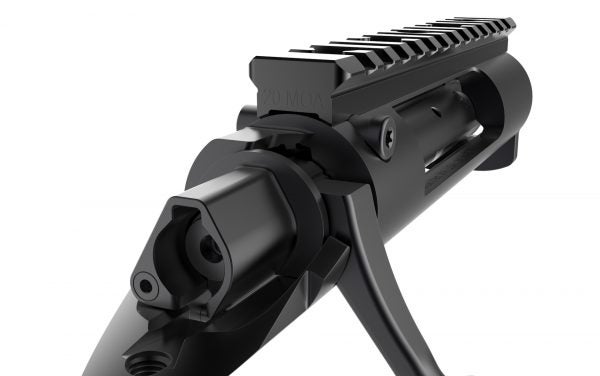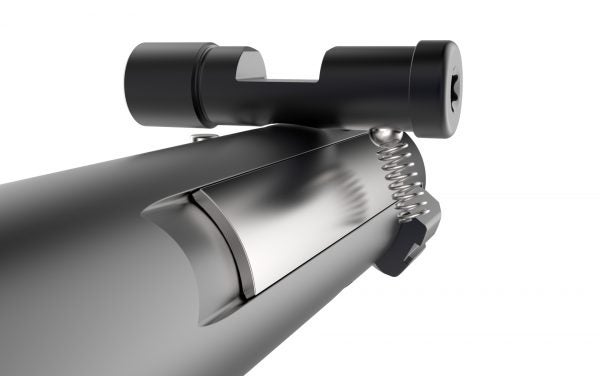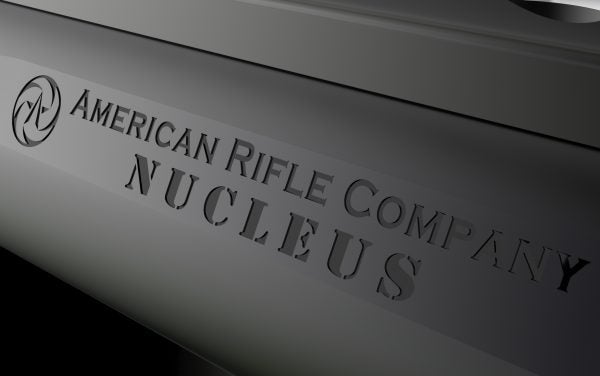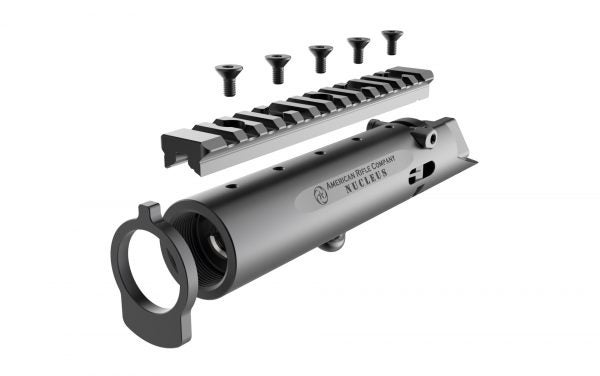Not being a long range precision shooter, I am going to write this new product announcement from American Rifle Company using simple words and a lot of pictures. The Nucleus is a Remington 700 compatible bolt action with some advanced features like three toroidal locking lugs, controllable Springfield inertial ejection, and an adjustable firing pin protrusion. Sadly, it doesn’t accept Glock mags.
In all seriousness, the Nucleus appears to have some advanced features that are probably really important to people who shoot at things more than 100 yards away. Unlike myself. Additional details and a link to the product page can be found below.







American Rifle Company NUCLEUS BOLT ACTION
- Proudly engineered and manufactured in the USA
- Three toroidal locking lugs (no lapping required)
- Controlled-round feed extractor
- Controllable Springfield inertial ejection
- Exceptionally smooth
- Corrosion resistant black nitride finish
- Three anti-bind rails
- Interchangeable bolt heads
- Dual cocking cams
- 100% cock on opening
- Integral bolt handle
- Ergonomic interchangeable bolt knobs
- Savage small shank pre-fit compatible barrel thread
- Keyed recoil lug, pinning not required
- Interchangeable scope mounting rails
- 062-inch diameter firing pin tip for small and large primers
- Adjustable firing pin protrusion
- Compatible with Rem 700 triggers
- Compatible with Rem 700 stocks and chassis
- Weight: Short action 2.1 lbs. | Long action 2.4 lbs.
- MSRP: $1000 ($850 preorder)
Barrel interface: The barrel thread specification for Nucleus is 1.063 – 20 UN 2B making it compatible with many off-the-shelf barrels such as Savage small-shank pre-fits. Conventionally threaded and shouldered barrels can also be used with the Nucleus. The distance from the bolt face to the forward face of the recoil lug is 0.825 +/-0.001 inches.
Bolt: The Nucleus uses a bolt that is machined from a single piece steel and subsequently heat-treated for strength. It has an integral handle making it practically impossible to break off. The bolt knob interface for the Nucleus is the same as that of the Mausingfield and unique to American Rifle Company. An integral cylindrical shaft extends through the knob thus maximizing strength.
Bolt Head: (Patented and patent pending) The Nucleus uses an interchangeable bolt head featuring three Toroidal locking lugs, each having an anti-bind slot that engages three corresponding anti-bind rails machined into the receiver using a wire EDM. The toroidal locking lugs bear against a spherical surface within the receiver thus obviating the need for lapping the bolt to the receiver. Bolt heads are available for the 223 Remington, the 300 Win Mag, and everything in between including the 224 Valkyrie and the 6.5 Swede.
Bolt Knobs: The Nucleus is designed for use with American Rifle Company’s proprietary bolt knobs that are ergonomically designed for enhanced control of the bolt while cycling the action. Learn more about why American Rifle Company’s bolt knobs are designed as they are and about their intended use by clicking here.
Bolt Manipulation: Cycling the Nucleus requires rotating the bolt by 72 degrees which is approximately the maximum possible without seriously compromising primary extraction. Dual cocking cams are used to increase cocking efficiency thus minimizing the force required to cock the action. The nucleus is 100% cock-on-opening. When the bolt is open, the placement of the bolt knob positions the hand well clear of the scope for unobstructed rearward and forward movement.
Bolt Shroud: The Nucleus uses a flanged bolt shroud like that of the Mauser 98 in that its flange obstructs the flow of rearward-moving gases and particles resulting from overpressure events and case head separations. Additionally, a spring-loaded locking pin like those of the Mausingfield and Mauser 98 prevents accidental rotation of the shroud with respect to the bolt when open and retracted. The locking pin obviates the need for detents at the aft end of the bolt which adversely affects the smoothness of the bolt cycle.
Bolt Stop: Substantial in size, the bolt stop of the Nucleus is extremely rugged and dependable. It is not pinned to the receiver. Instead, the bolt stop itself is a large pin that obstructs the 12 o’clock lug of the bolt head and transfers loads directly into the receiver. It will prove to be among the most rugged bolt stops ever used in bolt action rifles, on par with those of the Mauser 98 and the 1903 Springfield. Bolt removal is easy. Simply retract the bolt, rotate the bolt stop by 180 degrees, and remove the bolt. The bolt stop can only be rotated when the bolt is fully retracted thus preventing accidental removal. The center of mass of the bolt is located to prevent rotation under the high accelerations of recoil. Lastly, the forces associated with the bolt striking the bolt stop drive the bolt stop into engagement with the receiver.
Ejector: The Nucleus uses an ejector that is very similar to that used in the Model 1903 Springfield—a compact, hardened-steel ejector freely pivoting on a high-strength steel pin. It is located at the aft end of the receiver, well away from the breech where the blast resulting from an overpressure event or a case head failure would be most intense. The momentum of the rearward-moving bolt forces the ejector to pivot into engagement with the case head through a slot in the bolt face. The Springfield ejector also enables the shooter to control the intensity of the ejection process. It is the same ejector used in our Mausingfield bolt action and we encourage you to learn more about the ejector by clicking here.
Extractor: (Patent Pending) The Nucleus uses a claw type extractor which offers controlled-round feeding functionality while cooperating with the three-lug bolt design. It is well suited for cartridges ranging in size from the short 6mm Dasher all the way up to long magnums. Conceptually, its design is like that the famous Mauser 98 claw extractor in that it can engage the case head without the use additional springs or plungers. Instead, a compliant tail provides the spring force necessary for engaging the case head. The extractor is trapped between the bolt head and the bolt obviating the need for small pins. During extraction, the extractor slides forward to engage an undercut in the bolt head thus preventing accidental disengagement of the case head. The extractor of the Nucleus is an excellent example of an American Rifle Company comprehensive and highly engineered solution.
Magazine Compatibility: The Nucleus is compatible with American Rifle Company’s ARC mag, the Accuracy International CS mags (AI CS), Accurate mags like those from Accuracy International, and Alpha mags. It is not compatible with the Accuracy International’s AW mag.
Metallurgy: The Nucleus is made of high strength alloy steel. It is not made of stainless steel. The Nucleus undergoes a salt bath nitride finishing process to harden and blacken its surfaces. The resulting finish effectively resists corrosion and reduces friction thus enhancing the smoothness of the action.
Recoil Lug: (Patent Pending) The Nucleus has an innovative recoil lug that does not require pinning to maintain proper orientation with respect to the receiver during barrel installation. Instead, proper orientation is easily maintained by a tab which extends upwards from the top of the recoil lug and engages a slot cut into the bottom of scope mounting rail. The recoil lug is made from hardened steel and has a corrosion resistant, black nitride finish. Its thickness is 0.185 +/-0.0001 inches.
Scope Mounting Rail: Made from 7075 aluminum alloy, the rail has a black, hard-coat anodized finish. It is attached to the receiver using five high strength, 410 stainless steel, 8-36 screws. The overall length of the screws is 0.375 inches. The screws have conical heads (82° included angle) that engage conical bores within the rails thus establishing an over-constrained condition which effectively prevents any movement between the rail and the receiver. Additionally, the underside of the rail engages the cylindrical body of the receiver in a manner that effectively, and redundantly, prevents yaw. This solution ensures reliably, scope mounting choices, and economy. Rails are offered in 25 and 45 MOA inclinations.
Stock and Chassis Interface: The Nucleus is generally compatible with stocks and chassis designed for use with the Remington 700 and its clones. The bolt stop of the Nucleus is located near the top of the receiver and is therefore well clear of all stocks and chassis except for tubular chassis such as the Eliseo.
Striker Assembly: (Patent Pending) The Nucleus uses a dual cocking cam striker assembly for enhanced cocking efficiency thus reducing the effort required to cock the action. The 0.062-inch diameter striker (firing pin) tip reduces the likelihood of piercing small rifle primers. Adjustable tip protrusion from the bolt face is made possible by an interlocking nut and washer that also serves as the abutment for the striker spring. The striker is connected to the cocking piece by a thread. Complete passage of the striker through the cocking piece is prevented by a head at the aft end of the striker. Additionally, disassembly of the bolt assembly is facilitated by a threaded hole in the aft end of the striker into which a screw may be inserted to hold the striker in the rearward position against the main spring force. When the screw is in place, the striker assembly can easily be unscrewed and removed for the bolt assembly.
Trigger Interface: The Nucleus is compatible with aftermarket triggers designed for the Remington 700 and its clones. If possible, triggers should be purchased without the bolt stop releases. The Nucleus does not use a trigger hanger.
 Your Privacy Choices
Your Privacy Choices
